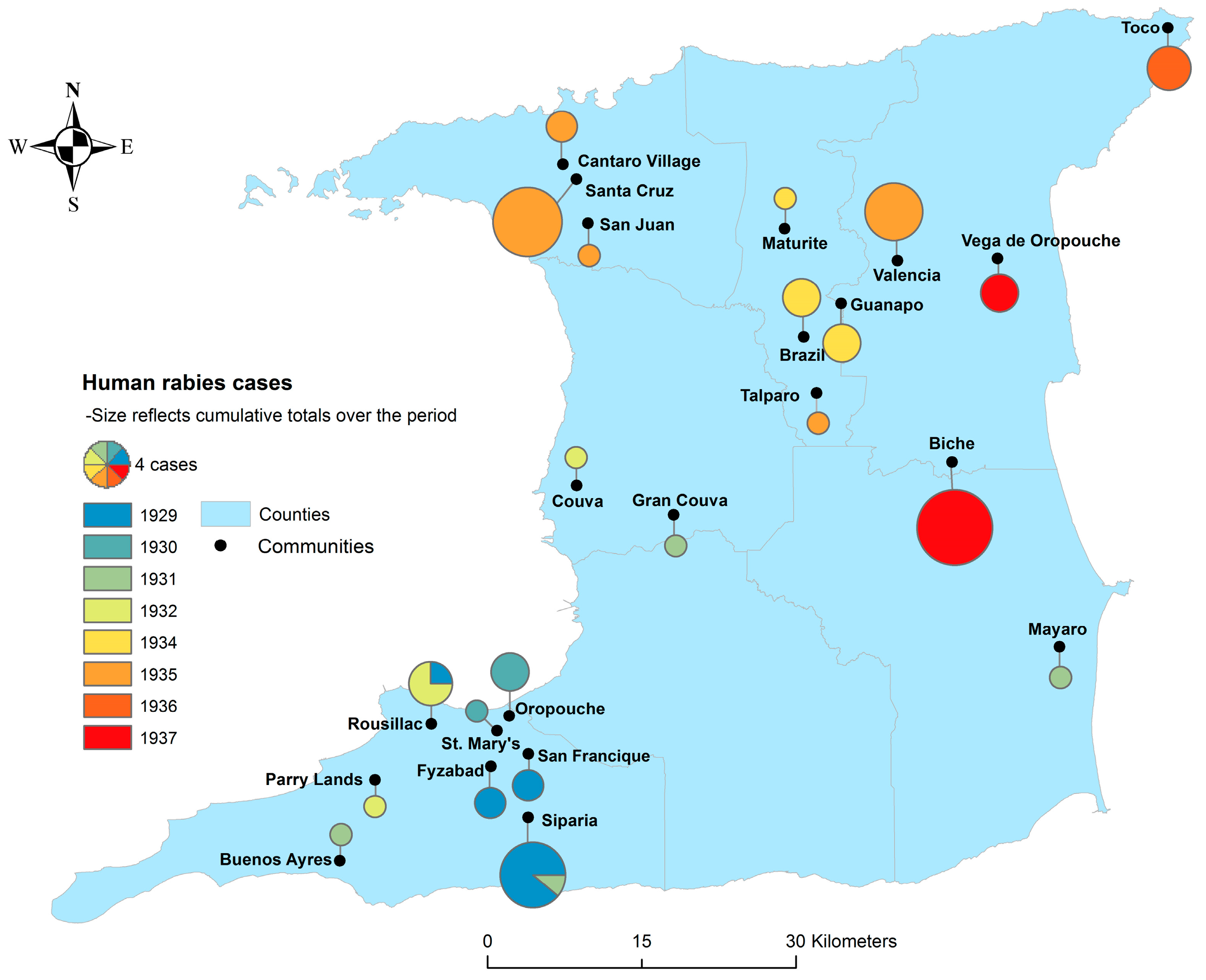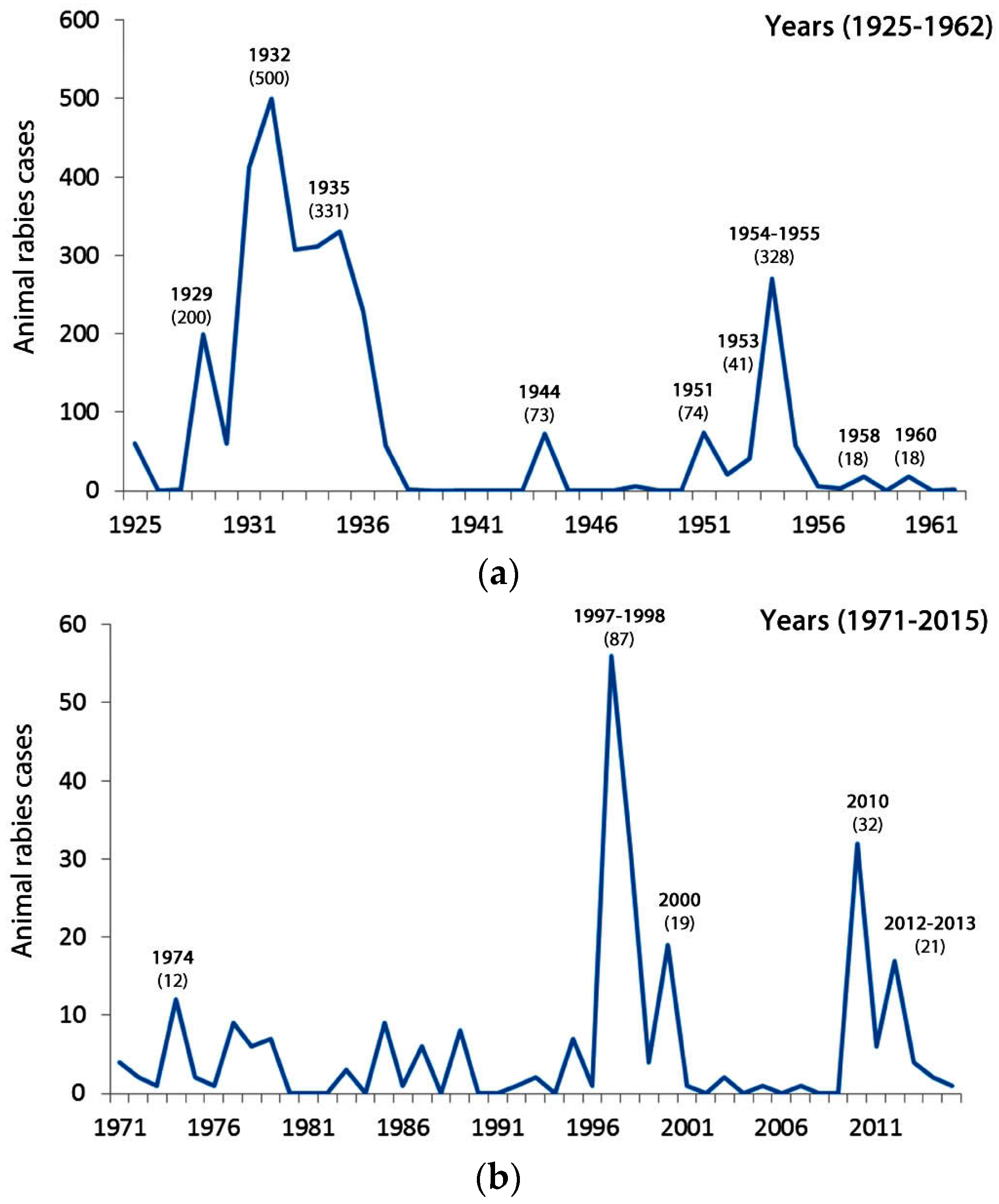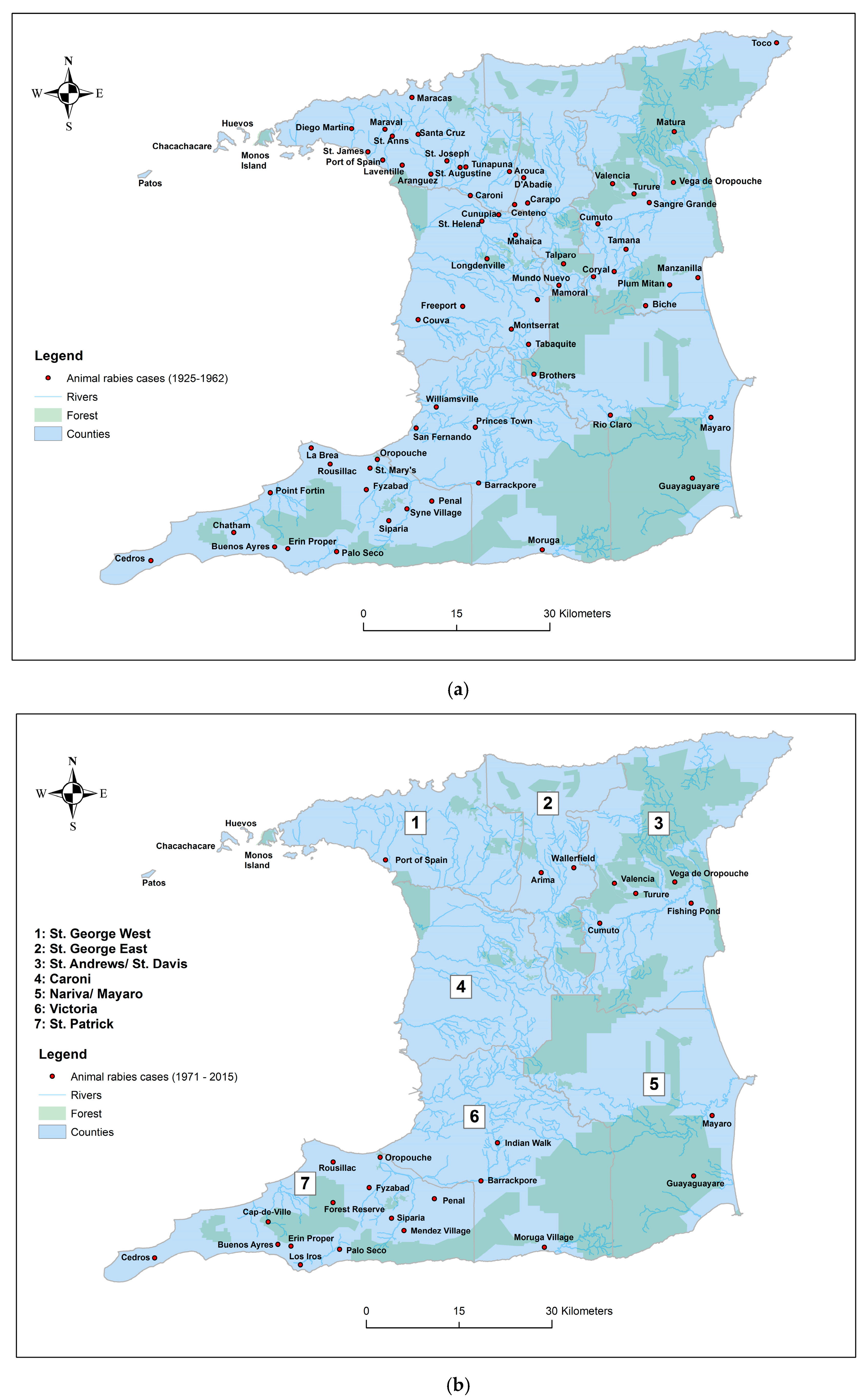The History of Rabies in Trinidad: Epidemiology and Control Measures
Abstract
:1. Introduction
2. Methodology
3. Epizootiology and Epidemiology in Susceptible Hosts
3.1. Terrestrial Rabies in Trinidad
3.2. Bat-Transmitted Rabies in Trinidad
4. Rabies Control and Prevention Strategies
4.1. Vampire Bat Population Control
4.2. Animal Vaccination
4.3. Surveillance
4.3.1. General Rabies Surveillance Activities and Surveillance in Livestock
4.3.2. Surveillance in the Bat Population
4.3.3. Surveillance in the Canine Population
4.3.4. Surveillance in the Mongoose Population and Other Terrestrial Wildlife Populations
4.4. Movement Control of Bats and Rabies Viruses
4.5. Human Vaccinationand Risk Communication Programs
5. Conclusions
Acknowledgments
Author Contributions
Conflicts of Interest
References
- Rupprecht, C.E.; Hanlon, C.A.; Hemachudha, T. Rabies re-examined. Lancet Infect. Dis. 2002, 2, 327–343. [Google Scholar] [CrossRef]
- Blanton, J.D.; Rupprecht, C.E. Travel vaccination for rabies. Expert Rev. Vaccines 2008, 7, 613–620. [Google Scholar] [CrossRef] [PubMed]
- Schneider, M.C.; Romijn, P.C.; Uieda, W.; Tamayo, H.; da Silva, D.F.; Belotto, A.; da Silva, J.B.; Leanes, L.F. Rabies transmitted by vampire bats to humans: An emerging zoonotic disease in Latin America? Rev. Panam. Salud Publ. 2009, 25, 260–269. [Google Scholar] [CrossRef]
- World Health Organization. Rabies vaccines: WHO position paper. Wkly. Epidemiol. Rec. 2010, 309, 309–320. [Google Scholar]
- World Health Organization (WHO) Expert Committee on Rabies. WHO Expert Consulation on Rabies; World Health Organization: Geneva, Switzerland, 2013; p. 982. [Google Scholar]
- Velasco-Villa, A.; Reeder, S.A.; Orciari, L.A.; Yager, P.A.; Franka, R.; Blanton, J.D.; Zuckero, L.; Hunt, P.; Oertli, E.H.; Robinson, L.E.; et al. Enzootic rabies elimination from dogs and re-emergence in wild terrestrial carnivores, United States. Emerg. Infect. Dis. 2008, 14, 1849–1854. [Google Scholar] [CrossRef] [PubMed]
- Greenhall, A.M. Effects of vampire bats and paralytic rabies on livestock production. In Parasites, Pests and Predators; Gaafar, S.M., Howards, W.E., Marsh, R.E., Eds.; Elsevier: Amsterdam, The Netherlands, 1985; pp. 537–553. [Google Scholar]
- Nadin-Davis, S.A.; Huang, W.; Armstrong, J.; Casey, G.A.; Bahloul, C.; Tordo, N.; Wandeler, A. Antigenic and genetic divergence of rabies viruses from bat species indigenous to Canada. Virus Res. 2001, 74, 139–156. [Google Scholar] [CrossRef]
- Johnson, N.; Arechiga-Ceballos, N.; Augilar-Setien, A. Vampire bat rabies: Ecology, epidemiology and control. Viruses 2014, 6, 1911–1928. [Google Scholar] [CrossRef] [PubMed]
- Greenhall, A.M. Bats, rabies and control problems. Oryx 1968, 9, 263–266. [Google Scholar] [CrossRef]
- World Health Organization (WHO) Expert Committee on Rabies. WHO Expert Committe on Rabies Fifth Report; World Health Organization: Geneva, Switzerland, 1966. [Google Scholar]
- Baer, G.M. The history of rabies. In Rabies, 2nd ed.; Jackson, A.C., Wunner, W.H., Eds.; Elsevier: London, UK, 2007; pp. 1–22. [Google Scholar]
- Childs, J.E.; Leslie, A.; Real, L.A. Epidemiology. In Rabies, 2nd ed.; Jackson, A.C., William, W.H., Eds.; Elsevier: London, UK, 2007; pp. 123–200. [Google Scholar]
- Carini, A. Defendiendo un diagnostico. Argent. Biol. 1913, 161. [Google Scholar]
- Pawan, J.L. The transmission of paralytic rabies in Trinidad by the vampire bat (Desmodus rotundus murinus wagner 1840). Ann. Trop. Med. Parasitol. 1936, 30, 101–129. [Google Scholar] [CrossRef]
- Metivier, H.V.M. Paralytic rabies in livestock. J. Comp. Pathol. Ther. 1935, 48, 245–260. [Google Scholar] [CrossRef]
- Waterman, J.A. Acute ascending rabic myelitis. Rabies—Transmitted by bats to human beings and animals. Caribb. Med. J. 1959, 21, 46–74. [Google Scholar] [PubMed]
- Novicky, R. Contribution to the study of bovine paralytic rabies in Venezuela. Can. J. Comp. Med. 1947, 11, 46–74. [Google Scholar]
- Nehaul, B.B.G. Rabies transmitted by bats in British Guiana. Am. J. Trop. Med. Hyg. 1955, 4, 550–553. [Google Scholar] [CrossRef] [PubMed]
- Greenhall, A.M. Profile of a vampire. Pageant 1952, 8, 52–57. [Google Scholar]
- Arellano-Sota, C. Vampire bat-transmitted rabies in cattle. Rev. Infect. Dis. 1988, 10, 707–709. [Google Scholar] [CrossRef]
- Gomes, G.A.; Reid, F.A. Bats of Trinidad and Tobago: A Field Guide and Natural History; Trinibats: Trinidad, Cuba, 2015. [Google Scholar]
- ffrench, R. A Guide to the Birds of Trinidad and Tobago, 2nd ed.; Cornell University Press: New York, NY, USA, 1991. [Google Scholar]
- Goodwin, G.G.; Greenhall, A.M. A Review of the Bats of Trinidad and Tobago: Descriptions, Rabies Infection and Ecology; Bulletin of the American Museum of Natural History: New York, NY, USA, 1961; p. 122. [Google Scholar]
- Hurst, E.W.; Pawan, J.L. An outbreak of rabies in Trinidad without history of bites, and with the symptoms of acute ascending myelitis. Lancet 1931, 218, 622–628. [Google Scholar] [CrossRef]
- De Verteuil, E.; Urich, F.W. The study and control of paralytic rabies transmitted by bats in Trinidad, british west indies. Trans. R. Soc. Trop. Med. Hyg. 1936, 29, 317–328. [Google Scholar] [CrossRef]
- Hurst, E.W.; Pawan, J.L. A further account of the Trinidad outbreak of acute rabic myelitis: Histology of the experimental disease. J. Pathol. Bacteriol. 1932, 35, 301–321. [Google Scholar] [CrossRef]
- Butcher, L.V. The present status of paralytic rabies (bat transmitted) in Trinidad. West Indian Med. J. 1958, 7, 17–20. [Google Scholar] [PubMed]
- De Mattos, C.A.; De Mattos, C.C.; Smith, J.S.; Miller, E.T.; Papo, A.; Utrea, A.; Osburn, B.I. Genetic characterization of rabies field isolates from Venezuela. J. Clin. Microbiol. 1996, 34, 1553–1558. [Google Scholar] [PubMed]
- Everard, C.O.R.; Everard, J.D. Mongoose rabies in the Caribbean. Ann. N. Y. Acad. Sci. 1992, 653, 356–366. [Google Scholar] [CrossRef] [PubMed]
- Director of Medical Services. Administration Report of the Surgeon General for the Year 1955; Department of Health: Port of Spain, Trinidad and Tobago, 1955.
- Director of Medical Services. Administration Report of the Surgeon General for the Year 1957; Department of Health: Port of Spain, Trinidad and Tobago, 1957.
- Pawan, J.L. Paralysis as a clinical manifestation in human rabies. Ann. Trop. Med. Parasitol. 1939, 33, 21–29. [Google Scholar] [CrossRef]
- Director of Agriculture of Trinidad and Tobago. Extracts from the adminstration reports of the director of agriculture for the years 1923–1948. Caribb. Med. J. 1959, 21, 172–184. [Google Scholar]
- Mungrue, K.; Mahabir, R. The rabies epidemic in Trinidad of 1923 to 1937: An evaluation with a geographic information system. Wilderness Environ. Med. 2011, 22, 28–36. [Google Scholar] [CrossRef] [PubMed]
- Director of Medical Services. Administration Report of the Surgeon General for the Year 1956; Department of Health: Port of Spain, Trinidad and Tobago, 1956.
- Seetahal, J.F.R.; Sanchez-Vazquez, M.J.; Vokaty, A.; Carrington, C.V.F.; Mahabir, R.; Adesiyun, A.A.; Rupprecht, C.E. Of bats and livestock: The epidemiology of rabies in Trinidad, West Indies. Unpublished manuscript, 14 Feburary 2017.
- Director of Medical Services. Administrative Report of the Surgeon General for the Year 1960; Department of Health: Port of Spain, Trinidad and Tobago, 1960.
- Pemberton, R. Animal disease and veterinary aministration in Trinidad and Tobago, 1879–1962. In Healing the Herds: Disease, Livestock Economies and the Globalization of Veterinary Medicine; Brown, K., Gilfoyle, D., Eds.; Ohio University Press: Athens, OH, USA, 2010; pp. 163–179. [Google Scholar]
- Acha, P.N. Epidemiology of paralytic bovine rabies and bat rabies. Bull. Off. Int. Epizooties 1967, 67, 343–382. [Google Scholar]
- Pawan, J.L. Fruit-eating bats and paralytic rabies in Trinidad. Ann. Trop. Med. Parasitol. 1948, 42, 173–177. [Google Scholar] [CrossRef] [PubMed]
- Pawan, J.L. Rabies in the vampire bat of Trinidad with special reference to the clinical course and the latency of infection. Ann. Trop. Med. Parasitol. 1936, 30, 137–156. [Google Scholar] [CrossRef]
- Bissessar, J.; Veterinary Diagnostic Laboratory, Ministry of Agriculture, Land and Fisheries, Trinidad and Tobago; Seetahal, J.F.R.; Champs Fleurs, Trinidad. Personal communication, May 2011.
- Seetahal, J.F.R. Molecular Epidemiology of Rabies in Trinidad and Characteristics of the 2010 Epizootic. Master’s Thesis, The University of the West Indies, Alma Jordan Library. St. Augustine Campus, St. Augustine, Trinidad and Tobago, 2011. [Google Scholar]
- National Surveillance Unit (NSU). NSU Administrative Report 2010; Ministry of Health: Port of Spain, Trinidad and Tobago, 2010.
- Greenhall, A.M. Problems and Ecological Implications in the Control of Vampire Bats. In Proceedings of the Latin American Conference on the Conservation of Renewable Natural Resources, San Carlos de Bariloche, Argentina, 27 March–2 April 1968. [Google Scholar]
- Belotto, A.; Leanes, L.F.; Schneider, M.C.; Tamayo, H.; Correa, E. Overview of rabies in the Americas. Virus Res. 2005, 111, 5–12. [Google Scholar] [CrossRef] [PubMed]
- Delpietro, H.; de Diaz, A.M.C.; Fuenzalida, E.; Bell, J.F. Determinacion de las tasa de ataque de rabia en murciclagos. Bol. Oficina Sanit. Panam. 1972, 73, 222–230. [Google Scholar] [PubMed]
- Smith, J.S.; Baer, G.M. Epizootiology of rabies: The Americas. In Rabies (Developments in Veterinary Virology); Campbell, J.B., Charlton, K.M., Eds.; Kluwe (Springer) Academic Publishers: Norwell, MA, USA, 1988; p. 452. [Google Scholar]
- Greenhall, A.M. Use of mist nets and strychnine for vampire control in Trinidad. J. Mammal. 1963, 44, 396–398. [Google Scholar] [CrossRef]
- Greenhall, A.M. Vampire bat control in the americas: A review and proposed program for action. Bull. Pan Am. Health Organ. 1974, 8, 30–36. [Google Scholar]
- World Health Organization. WHO Expert Committe on Rabies Sixth Report; World Health Organization: Geneva, Switzerland, 1973. [Google Scholar]
- Streicker, D.G.R.S.; Valderrama, W.; Gomez, J.; Benavides, I.V.; Pacheco, V.; Condori, R.E.; Montgomery, J.; Rupprecht, C.; Rohani, P.; Altizer, S. Ecological and anthropogenic drivers of rabies exposure in vampire bats: Implications for transmission and control. Proc. R. Soc. Lond. B Biol. Sci. 2012, 279, 3384–3392. [Google Scholar] [CrossRef] [PubMed]
- Streicker, D.G.; Winternitz, J.C.; Satterfield, D.A.; Condori-Condori, R.E.; Broos, A.; Tello, C.; Recuenco, S.; Velasco-Villa, A.; Altizer, S.; Valderrama, W. Host-pathogen evolutionary signature reveal dynamics and future invasions of vampire bat rabies. Proc. Natl. Acad. Sci. USA 2016, 113, 10926–10931. [Google Scholar] [CrossRef] [PubMed]
- International Union for the Conservation of Nature and Natural Resources (IUCN). Resolution No. 1. Vampire Bats. In Proceedings of the IUCN Latin American Conference on the Conservation of Renewable Natural Resources, San Carlos Bariloche, Argentina, 27 March–2 April 1968. [Google Scholar]
- Stoner-Duncan, B.; Streicker, D.G.; Tedeschi, C.M. Vampire bats and rabies: Towards an ecological solution to a public health problem. PLoS Negl. Trop. Dis. 2014, 8. [Google Scholar] [CrossRef] [PubMed]
- Government of Trinidad and Tobago. Paralytic rabies regulations. Animals (diseases and importation) act. In Laws of Trinidad and Tobago; Ministry of Legal Affairs: Port of Spain, Trinidad and Tobago, 1956; Chapter 67:02; pp. 62–65. [Google Scholar]
- Gilbert, A.; Greenberg, L.; Moran, D.; Alvarez, D.; Alvarado, M.; Garcia, D.L.; Peruski, L. Antibody response of cattle to vaccination with commercial modified live rabies vaccines in Guatemala. Prev. Vet. Med. 2015, 118, 36–44. [Google Scholar] [CrossRef] [PubMed]
- Seetahal, J.F.R.; Vokaty, A.; Pradel, J.; Carrington, C.V.F.; Louison, B.; Roopnarine, R.; Van Sauers, A.; James, C.; Millien, M.F.; Rupprecht, C.E. Rabies in the Caribbean: A Situation Analysis. In Proceedings of the Xth International Congress for Veterinary Virology, Montpellier, France, 31 August–3 September 2015. [Google Scholar]
- Veterinary Services. Annual Report 2009; Veterinary Services, Animal Production and Health Division; Ministry of Agriculture Land and Fisheries: Port of Spain, Trinidad and Tobago, 2009.
- Trinidad and Tobago Central Statistical Office. Agricultural Census. Agricultural Statistics 2004. Available online: http://www.cso.gov.tt/statistics/ (accessed on 1 July 2011).
- Phillip-Hosein, A.; Penal Demonstration Station, Ministry of Agriculture, Land and Fisheries, Trinidad and Tobago; Seetahal, J.F.R.; Champs Fleurs, Trinidad. Personal communication, April 2017.
- Government of Trinidad and Tobago. Animals (importation) control regulations. Animals (diseases and importation) act. In Laws of Trinidad and Tobago; Ministry of Legal Affairs: Port of Spain, Trinidad and Tobago, 1956; Chapter 67:02; pp. 88–106. [Google Scholar]
- Seetahal, J.F.R.; Velasco-Villa, A.; Allicock, O.M.; Adesiyun, A.A.; Bissessar, J.; Amor, K.; Phillip-Hosein, A.; Marston, D.A.; McElhinney, L.M.; Shi, M.; et al. Evolutionary history and phylogeography of rabies viruses associated with outbreaks in Trinidad. PLoS Negl. Trop. Dis. 2013, 7. [Google Scholar] [CrossRef] [PubMed]
- Surgeon General of Trinidad and Tobago. Extracts from the administration report of the surgeon general 1925–1941. In Caribbean Medical Journal: Paralytic Rabies Transmitted by Bats in Trinidad; Waterman, J.A., Ed.; Trinidad and Tobago Medical Association: Cascade, Trinidad and Tobago, 1959; pp. 204–238. [Google Scholar]
- World Health Organization. Transmission of rabies by bats in the Americas. WHO Chron. 1962, 16, 447–450. [Google Scholar]
- Blanton, J.D.; Dyer, J.; Mc Brayer, J.; Rupprecht, C.E. Rabies surveillance in the United States during 2011. J. Am. Vet. Med. Assoc. 2012, 24, 712–722. [Google Scholar] [CrossRef] [PubMed]
- Greenhall, A.M. Bats: Their Public Health Importance and Control with Special Reference to Trinidad. In Proceedings of the 2nd Vertebrate Pest Control Conference, Anaheim, CA, USA, 4–5 March 1964. [Google Scholar]
- Escobar, L.E.; Peterson, A.T.; Favi, M.; Yung, V.; Medina-Vog, G. Bat-borne rabies in Latin America. Rev. Inst. Med. Trop. Sao Paulo 2015, 57, 63–72. [Google Scholar] [CrossRef] [PubMed]
- Linhart, S.B.; Crespo, R.F.; Mitchel, G.C. Control of vampire bats by topical application of an anticoagulant, chlorophacinone. Bol. Oficina Sanit. Panam. 1972, 1, 31–38. [Google Scholar]
- Lord, R.D. An ecological strategy for controlling rabies through the elimination of vampire bats. Proc. Verteb. Pest Conf. 1980, 9, 4–6. [Google Scholar]
- Williams, E. History of the People of Trinidad and Tobago; Frederick A. Praeger Inc. Publisher: New York, NY, USA, 1962; p. 287. [Google Scholar]
- Kaplan, C. Rabies: A worldwide disease. In Population Dynamics of Rabies in Wildlife; Bacon, P.J., Ed.; Academic Press Inc. (London) Ltd.: London, UK, 1985. [Google Scholar]
- Herrera, H.D. Vampires in ‘guaya’. Available online: http://www.trinidadexpress.com/20160608/features/vampires-in-8216guaya8217 (accessed on 5 May 2017).
- Brown, C.M.; Slavinski, S.; Ettestad, P.; Sidwa, T.J.; Sorhage, F.E. Compendium of animal rabies prevention and control, 2016. J. Am. Vet. Med. Assoc. 2016, 248, 505–517. [Google Scholar] [PubMed]
- Hanlon, C.A.; Niezgoda, M.; Rupprecht, C.E. Postexposure prophylaxis for prevention of rabies in dogs. Am. J. Vet. Res. 2002, 63, 1096–1100. [Google Scholar] [CrossRef] [PubMed]
- Everard, C.O.R.; Everard, J.D. Mongoose rabies in Grenada. In Population Dynamics of Rabies in Wildlife; Bacon, P.J., Ed.; Academic Press Inc. (London) Ltd.: London, UK, 1985; p. 358. [Google Scholar]
- Schneider, M.C.; Belotto, A.; Ade, M.P.; Leanes, L.F.; Correa, E.; Tamayo, H.; Medina, G.; Rodrigues, M.J.; Consultores, O.P.S. Epidemiologic situation of human rabies in Latin America in 2004. Epidemiol. Bull. Pan Am. Health Organ. 2005, 26, 2–4. [Google Scholar]
- Favoretto, S.R.; De Mattos, C.C.; de Morais, N.B.; Carrieri, M.L.; Rolim, B.N.; Silva, L.M.; Rupprecht, C.E.; Durigon, E.L.; de Mattos, C.A. Rabies virus maintained by dogs in humans and terrestrial wildlife, Ceara State, Brazil. Emerg. Infect. Dis. 2006, 12, 1978–1981. [Google Scholar] [CrossRef] [PubMed]
- Leffingwell, L.M.; Neill, S.U. Naturally acquired rabies in an armadillo (Dasypus novemcinctus) in Texas. J. Clin. Microbiol. 1989, 27, 174–175. [Google Scholar] [PubMed]
- Greenhall, A.M.; Joermann, G.; Schmidt, U.; Seidel, M.R. Desmodus rotundus. Mamm. Species 1983, 202, 1–6. [Google Scholar] [CrossRef]
- Malaga-Alba, A. Vampire bat as a carrier of rabies. Am. J. Public Health 1954, 44, 909–918. [Google Scholar] [CrossRef]
- Food and Agricultural Organization (FAO). Global Forest Resources Assessment 2010: Main Report; FAO: Rome, Italy, 2010; p. 163. [Google Scholar]
- Delpietro, H.A.; Larghi, O.P.; Russo, R.G. Virus isolation from saliva and salivary glands of cattle naturally infected with paralytic rabies. Prev. Vet. Med. 2001, 48, 223–228. [Google Scholar] [CrossRef]
- De Brito, M.G.; Chamone, T.L.; da Silva, F.; Wada, M.Y.; de Miranda, A.B.; Castilho, J.G. Antemortem diagnosis of human rabies in a veterinarian infected when handling a herbivore in Minas Gerais, Brazil. Rev. Inst. Med. Trop. São Paulo 2011, 53, 39–44. [Google Scholar] [CrossRef]
- Kreindel, S.M.; McGuill, M.; Meltzer, M.; Rupprecht, C.; DeMaria, A. The cost of rabies postexposure prophylaxis: One state’s experience. Public Health Rep. 1998, 113, 247–251. [Google Scholar] [PubMed]
- Constantine, D.G. Transmission of pathogenic organisms by vampire bats. In Natural History of Vampire Bats; Greenhall, A.M., Schmidt, U., Eds.; CDC Press: Boca Raton, FL, USA, 1988; pp. 167–189. [Google Scholar]



© 2017 by the authors. Licensee MDPI, Basel, Switzerland. This article is an open access article distributed under the terms and conditions of the Creative Commons Attribution (CC BY) license (http://creativecommons.org/licenses/by/4.0/).
Share and Cite
Seetahal, J.F.R.; Vokaty, A.; Carrington, C.V.F.; Adesiyun, A.A.; Mahabir, R.; Hinds, A.Q.J.; Rupprecht, C.E. The History of Rabies in Trinidad: Epidemiology and Control Measures. Trop. Med. Infect. Dis. 2017, 2, 27. https://doi.org/10.3390/tropicalmed2030027
Seetahal JFR, Vokaty A, Carrington CVF, Adesiyun AA, Mahabir R, Hinds AQJ, Rupprecht CE. The History of Rabies in Trinidad: Epidemiology and Control Measures. Tropical Medicine and Infectious Disease. 2017; 2(3):27. https://doi.org/10.3390/tropicalmed2030027
Chicago/Turabian StyleSeetahal, Janine F. R., Alexandra Vokaty, Christine V.F. Carrington, Abiodun A. Adesiyun, Ron Mahabir, Avery Q. J. Hinds, and Charles E. Rupprecht. 2017. "The History of Rabies in Trinidad: Epidemiology and Control Measures" Tropical Medicine and Infectious Disease 2, no. 3: 27. https://doi.org/10.3390/tropicalmed2030027




